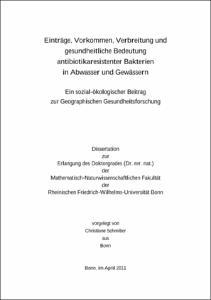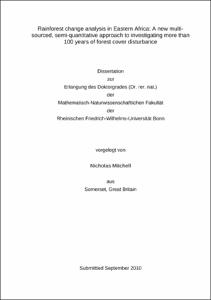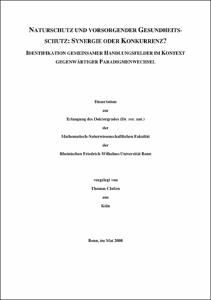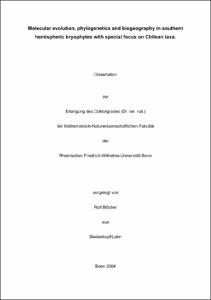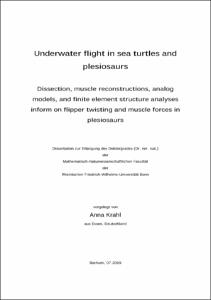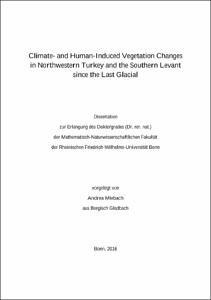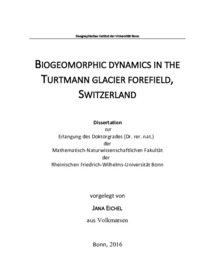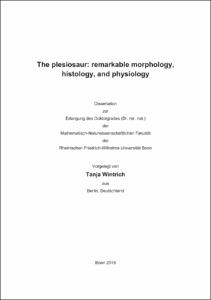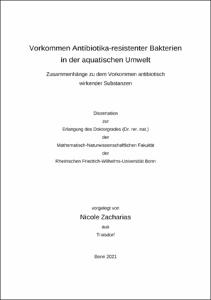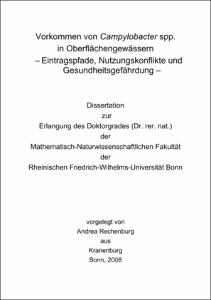E-Dissertationen: Suche
Anzeige der Dokumente 1-10 von 11
Einträge, Vorkommen, Verbreitung und gesundheitliche Bedeutung antibiotikaresistenter Bakterien in Abwasser und Gewässern: Ein sozial-ökologischer Beitrag zur Geographischen Gesundheitsforschung
(2011-11-29)
Antibiotika gelangen über natürliche Ausscheidung von Mensch und Tier sowie unsachgemäße Entsorgung in die Umwelt. Wichtige Eintragspfade stellen Abwasser, Klärschlamm und Gülle dar. Mikroorganismen können Resistenzen gegen ...
Rainforest change analysis in Eastern Africa: A new multisourced, semi-quantitative approach to investigating more than 100 years of forest cover disturbance
(2012-01-11)
Forest change and disturbance of the past strongly influence the state of today’s forests and their biodiversity. However, knowledge of former forest landscape states can be subject to misunderstanding and the practical ...
Naturschutz und vorsorgender Gesundheitsschutz: Synergie oder Konkurrenz?: Identifikation gemeinsamer Handlungsfelder im Kontext gegenwärtiger Paradigmenwechsel
(2008)
Einleitung
Menschen haben ihre Lebensumwelt schon immer genutzt und gestaltet. Dabei bezwangen sie eine Reihe natürlicher Gesundheitsrisiken über technologische und hygienische Fortschritte mit positiven Folgen ...
Menschen haben ihre Lebensumwelt schon immer genutzt und gestaltet. Dabei bezwangen sie eine Reihe natürlicher Gesundheitsrisiken über technologische und hygienische Fortschritte mit positiven Folgen ...
Molecular evolution, phylogenetics and biogeography in southern hemispheric bryophytes with special focus on Chilean taxa
(2005)
Researchers have long been fascinated by disjunct distribution patterns of plant and animal species. Especially the disjunctly distributed species occurring in the temperate Chilean and New Zealand rainforests of the ...
Underwater flight in sea turtles and plesiosaurs: Dissection, muscle reconstructions, analog models, and finite element structure analyses inform on flipper twisting and muscle forces in plesiosaurs
(2020-08-13)
This dissertation contributes to our understanding of plesiosaur locomotion by providing foreflipper and hindflipper muscle reconstructions and studying aspects of their muscle physiology (functions, forces, muscle length ......
Climate- and Human-Induced Vegetation Changes in Northwestern Turkey and the Southern Levant since the Last Glacial
(2017-04-20)
Northwestern Turkey and the southern Levant are key regions for studying vegetation and climate developments during migration phases of modern humans and the origin and expansion of agriculture. Both regions have a long ...
Biogeomorphic dynamics in the Turtmann glacier forefield, Switzerland
(2017-05-19)
Worldwide, glacier retreat enlarges glacier foreland areas, which are characterized by pronounced geomorphic and ecologic dynamics. Feedbacks between these dynamics are believed to drive glacier foreland landscape development, ...
The plesiosaur: remarkable morphology, histology, and physiology
(2019-07-04)
In this dissertation, contributions to understanding the morphology, histology, and physiology of plesiosaurs, a major group of marine reptiles from the Age of Dinosaurs, are presented. By using comparative methods and new ......
Vorkommen Antibiotika-resistenter Bakterien in der aquatischen Umwelt: Zusammenhänge zu dem Vorkommen antibiotisch wirkender Substanzen
(2022-01-05)
Ein Anstieg der Resistenzen bei gleichzeitiger Stagnation hinsichtlich der Ent-wicklung neuer Antibiotika ist vor allem für Infektionen mit Gram-negativen Bakte-rien kritisch. Die WHO spezifizierte bereits 2014 ...
Vorkommen von Campylobacter spp. in Oberflächengewässern: Eintragspfade, Nutzungskonflikte und Gesundheitsgefährdung
(2009-05-25)
Campylobacterinfektionen sind weltweit verbreitet und weisen in Deutschland die höchste Inzidenz der bakteriellen Gastroenteritiden auf. Als Infektionsquelle ist neben Lebensmitteln auch Wasser zu nennen, dessen Bedeutung ...


